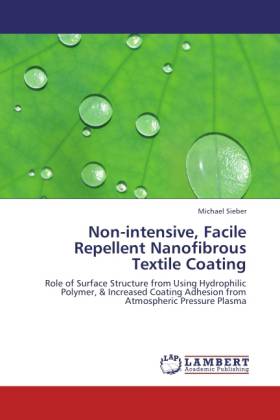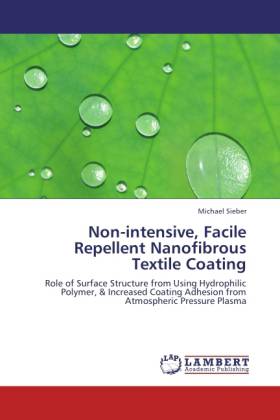
- Afhalen na 1 uur in een winkel met voorraad
- Gratis thuislevering in België vanaf € 30
- Ruim aanbod met 7 miljoen producten
- Afhalen na 1 uur in een winkel met voorraad
- Gratis thuislevering in België vanaf € 30
- Ruim aanbod met 7 miljoen producten
Zoeken
Non-intensive, Facile Repellent Nanofibrous Textile Coating
Role of Surface Structure from Using Hydrophilic Polymer, & Increased Coating Adhesion from Atmospheric Pressure Plasma
Michael Sieber
Paperback | Engels
€ 58,45
+ 116 punten
Omschrijving
The purpose of this work is to utilize atmospheric plasma to increase coating adhesion between textile substrate and a surface which is repellent to liquid water, formed using electrospun nanofibers (NFs). Atmospheric pressure plasma and electrospinning can be scaled to industrial levels and promise cost and energy savings relative to many current textile finishing methods. A quick, simple and durable hydrophobic finishing process for woven military Nylon 6,6/cotton fabric is demonstrated, maintaining similar bulk garment characteristics like moisture vapor transmission to promote necessary dissipation of heat. The promotion of necessary heat transfer while providing protection against chemical and thermal hazards using a multilayered garment approach has become important for many textile applications including military and industrial uses for Chemical-Biological hazard protection, as well as medical and activewear textiles. Incorporation of a NF coating with a fabric imparts composite multifunctional properties, while demonstrating the potential for greatly decreased processing time and uses less water, energy, and hazardous chemicals than traditional finishing techniques.
Specificaties
Betrokkenen
- Auteur(s):
- Uitgeverij:
Inhoud
- Aantal bladzijden:
- 144
- Taal:
- Engels
Eigenschappen
- Productcode (EAN):
- 9783846555439
- Verschijningsdatum:
- 9/12/2011
- Uitvoering:
- Paperback
- Formaat:
- Trade paperback (VS)
- Afmetingen:
- 152 mm x 229 mm
- Gewicht:
- 222 g

Alleen bij Standaard Boekhandel
+ 116 punten op je klantenkaart van Standaard Boekhandel
Beoordelingen
We publiceren alleen reviews die voldoen aan de voorwaarden voor reviews. Bekijk onze voorwaarden voor reviews.











